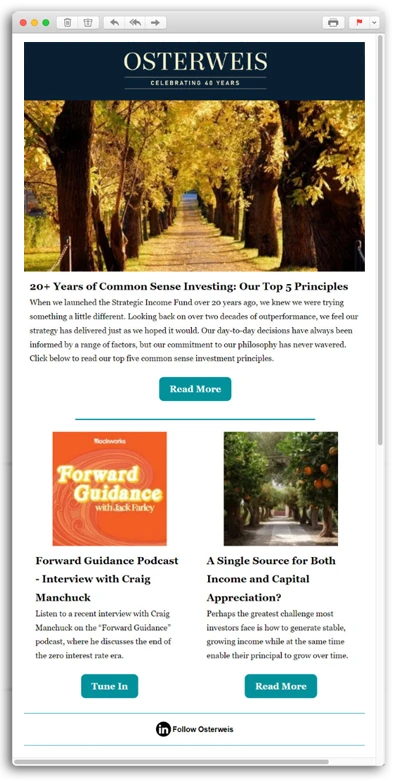Second Quarter Growth & Income Outlook
Published on April 15, 2025
We are carefully monitoring the effects of the Trump administration’s policy changes, which could hurt both consumers and businesses, but we believe the U.S. still possesses structural advantages for investors.
American Exceptionalism Reexamined
“There are decades when nothing happens; and there are weeks when decades happen.” - Attributed to Vladimir Ilyich Ulyanov (Vladimir Lenin)
A Changing of the Guard
You might not expect an investment outlook to use a quote from one of the fathers of communism, but we think the statement above aptly captures the moment. Since Donald Trump stepped back into power as president several weeks ago, the world as we knew it seems to have been turned on its head. In our fourth quarter outlook published in October 2024, we laid out a case for why the U.S. offers the most attractive investment environment globally. Given the whirlwind of economic and political changes in the U.S., as well as dramatic developments in China and Europe, we think it is critical to reexamine our conclusion and reassess whether the U.S. remains as attractive as we postulated. In other words, does so-called “American exceptionalism” still hold?
Importantly, this outlook is not meant as a political appraisal of President Trump; rather, it is an analysis of the economic consequences of the Trump agenda. We will continue to monitor the administration’s economic policies closely so that we can respond constructively and proactively in order to limit any negative impact on client portfolios.
U.S. Policy Under Trump: Flood the Zone
If it feels like every day brings a new set of dramatic policy changes by the Trump administration, then you would be right. In fact, Trump’s key political adviser Steve Bannon laid out this very strategy to overwhelm both the media and any political opposition. The idea is to effectively paralyze opposition by disorienting society with a torrent of policy changes and initiatives. Bannon calls it “flooding the zone.”
To frame the impact, consider just some of the key policy changes that have been enacted in recent weeks:
- Cancellation of billions of dollars in federal grants to state governments, universities, and research institutions
- Presidential order to dismantle the Department of Education
- Mass layoffs and/or “buyouts” of federal workers, totaling well into the tens of thousands
- Sweeping set of tariffs that amount to the highest trade barriers in more than a century
- Withdrawing political support for certain key foreign alliances in Europe
- Deportation of undocumented migrants with little to no due process
We would argue that this inexhaustive list of policy changes signals a clear shift in at least three ways. First, these changes reflect an attempt to reduce the size and scope of government. Second, the new policies signal an attempt to reverse many of the effects of globalization — from trading partnerships to military alliances to transnational labor. Third, the Trump administration is attempting to structurally weaken the U.S. dollar.
While these three changes may each seem reasonable, we think they carry significant long-term risks. Reducing the size of government sounds benign, but it has a multiplier impact on GDP and employment rates. Furthermore, and more importantly for the long term, certain societal functions — from operating stable and credible regulatory bodies to maintaining a federal highway system — are best left to the government, and reducing funding can undermine these critical functions. Third, reducing R&D funding and education funding reflects a growing anti-intellectualism that over the long term jeopardizes our key role in innovation with respect to health care and technology, as government funding is critical to the well-being of the U.S. university and research system.
Reversing globalization has some merits in our view, as the deindustrialization of the U.S. devastated many American communities and structurally helped undermine wage growth for decades. In addition, the Covid-19 pandemic exposed the vulnerability of our supply chain for strategically important goods such as certain medicines, leading-edge chips, and rare earth resources. However, rapid deglobalization, especially via significant and indiscriminate tariffs, can create a more unstable multi-polar world with high levels of uncertainty that inhibit planning by households and businesses. Tariffs also lead to inflation, which endangers the stability of any economy. Consider that the Smoot-Hawley Tariff signed into law by Herbert Hoover in 1930 is widely blamed for materially worsening the Great Depression by causing a massive trade war that reduced global commerce.
Weakening the U.S. dollar may seem smart on paper, as it would make our exports cheaper and reduce trade deficits. However, trade deficits and a strong U.S. dollar are the result of decades of financial account surpluses and the dollar functioning as the global reserve currency. This has enabled the U.S. federal government to borrow freely at low cost to fund a massive global military and significant social benefits like Medicare, Medicaid, and Social Security. Risking the global reserve currency status of the U.S. dollar is particularly dangerous and could cause broad financial instability and would strip away a key advantage the U.S. has enjoyed for decades.
In short, we think the Trump policies enacted so far undermine long-term U.S. interests and harm consumers and businesses.
Meanwhile, Over in China and Europe…
Significant developments also took place abroad over the past several months — some completely unrelated to the Trump administration and others in direct response to their policies.
In China, DeepSeek’s large language model was released after reportedly spending just a few million dollars. In contrast, OpenAI (the company behind ChatGPT) invested tens of billions of dollars to develop its large language models. Bloomberg reports that the DeepSeek release helped reinvigorate the Chinese technology market, with massive investments by Chinese tech firms now being directed at both improving AI functionality and lowering costs more broadly. Chinese companies are also making significant strides in biotech. In fact, The Wall Street Journal reports that “in 2020, less than 5% of large pharmaceutical transactions worth $50 million or more upfront involved China. By 2024, that number had surged to nearly 30% ... China’s biotech boom mirrors its rise in tech. In both cases, China has moved up the value chain, from manufacturing goods to becoming a more sophisticated hub for innovation.” China’s rise in both health care and technology stems in part from a vibrant education system funded by the central government. Importantly, China’s government has increased investment in education and has dramatically narrowed the gap versus the U.S. China’s education spending as a percentage of GDP was roughly 2.5% in 1998 and reached about 4.2% by 2020, compared to the U.S. at roughly 5% over the entire period.
While Europe is not seeing the same recent breakthroughs in technology and biotech research as China, the federal governments of Germany and the U.K. both recently announced significant increases in military spending in direct response to the tariffs and reordering of alliances led by the U.S. The EU is following suit and specifically calling for investing in European companies to bolster defenses. With hundreds of billions of dollars being spent by European governments on military and defense, we would expect the technology sector on the continent to benefit over time, and we would expect the investment to be broadly stimulative to western Europe’s economies. Importantly, Europe already boasts highly advanced businesses across the industrial, health care, and technology sectors and has leading university and research institutions, so greater investment in the domestic economy could have significant positive impacts over time.
Keep Calm and Consider the Long Term
So far, we have painted a pretty grim picture of U.S. prospects, especially relative to Europe and China. However, it is critical to keep several points in mind. First, the Trump administration may not succeed in fully implementing many of its policies. Courts have already blocked many of their proposals, such as deportation requests and mass firing of workers, and the judicial system may prevent other policies from being enacted. Second, Trump appears to be much more organized and committed this time around, but we would not be surprised if his administration falls prey to the vicious infighting that characterized, and in many ways paralyzed his first term. We also would expect that at least some of his pronouncements are walked back, as happened often in his first term. Third, the U.S. still enjoys favorable demographics, property rights, and rule of law. While we are concerned about the Trump administration threatening the rule of law, we believe institutions in the U.S. are strong enough to hold up to current threats. Federal elections every two years also play a critical role in reining in presidential power.
China, in contrast, has much weaker protections for property rights, especially for foreign investors. The government’s heavy involvement in certain sectors like the real estate market can also create significant distortions that make investing difficult. And, as we documented in our fourth quarter outlook, the country faces extremely challenging demographic trends, creating a litany of risks for investors over time.
Europe does face a stagnant population, but we view the sudden reinvigoration of investment in the continent as a distinct positive. We have long invested in European companies, and we are spending more time researching industries and businesses that may benefit from stronger economic activity going forward as the continent begins to reindustrialize.
We still believe the U.S. enjoys long-term structural tailwinds that advantage it over other economies. However, we are not ignoring the current developments and continue to monitor them closely.
Importantly, we have constructed an equity portfolio of very high quality, well-capitalized companies that we believe will survive and thrive in most environments. We will continue to employ a balanced approach of owning both offensive and defensive positions. In fixed income, we are positioned defensively, buying shorter maturity, higher quality bonds, which should dampen near-term volatility while we search for value in longer-dated bonds. Additionally, we have increased our cash reserves, so if we see attractive buying opportunities in either the equity or fixed income markets, we are in a good position to add to our portfolio.
We thank you for your continued confidence in our management.
John Osterweis
Founder, Chairman & Co-Chief Investment Officer – Core Equity
Gregory Hermanski
Co-Chief Investment Officer – Core Equity
Nael Fakhry
Co-Chief Investment Officer – Core Equity
Carl Kaufman
Co-President, Co-Chief Executive Officer, Chief Investment Officer – Strategic Income & Managing Director – Fixed Income
The Osterweis Funds are available by prospectus only. The Funds’ investment objectives, risks, charges, and expenses must be considered carefully before investing. The summary and statutory prospectuses contain this and other important information about the Funds. You may obtain a summary or statutory prospectus by calling toll free at (866) 236-0050, or by visiting www.osterweis.com/statpro. Please read the prospectus carefully before investing to ensure the Fund is appropriate for your goals and risk tolerance.
Mutual fund investing involves risk. Principal loss is possible.
Past performance does not guarantee future results. Index performance is not indicative of fund performance. To obtain fund performance, visit https://www.osterweis.com/mutual_funds/growth_income/performance.
This commentary contains the current opinions of the authors as of the date above, which are subject to change at any time, are not guaranteed, and should not be considered investment advice. This commentary has been distributed for informational purposes only and is not a recommendation or offer of any particular security, strategy, or investment product. Information contained herein has been obtained from sources believed to be reliable but is not guaranteed.
No part of this article may be reproduced in any form, or referred to in any other publication, without the express written permission of Osterweis Capital Management.
Current and future holdings are subject to risk.
Complete holdings of all Osterweis mutual funds (“Funds”) are generally available ten business days following quarter end. Holdings and sector allocations may change at any time due to ongoing portfolio management. Fund holdings for the Growth & Income Fund as of the most recent quarter end are available here: https://www.osterweis.com/mutual_funds/growth_income/portfolio
As of 3/31/25 the Osterweis Growth & Income did not hold a position in OpenAI or DeepSeek.
Osterweis Capital Management is the adviser to the Osterweis Funds, which are distributed by Quasar Distributors, LLC. [OCMI-719533-2025-04-11]








